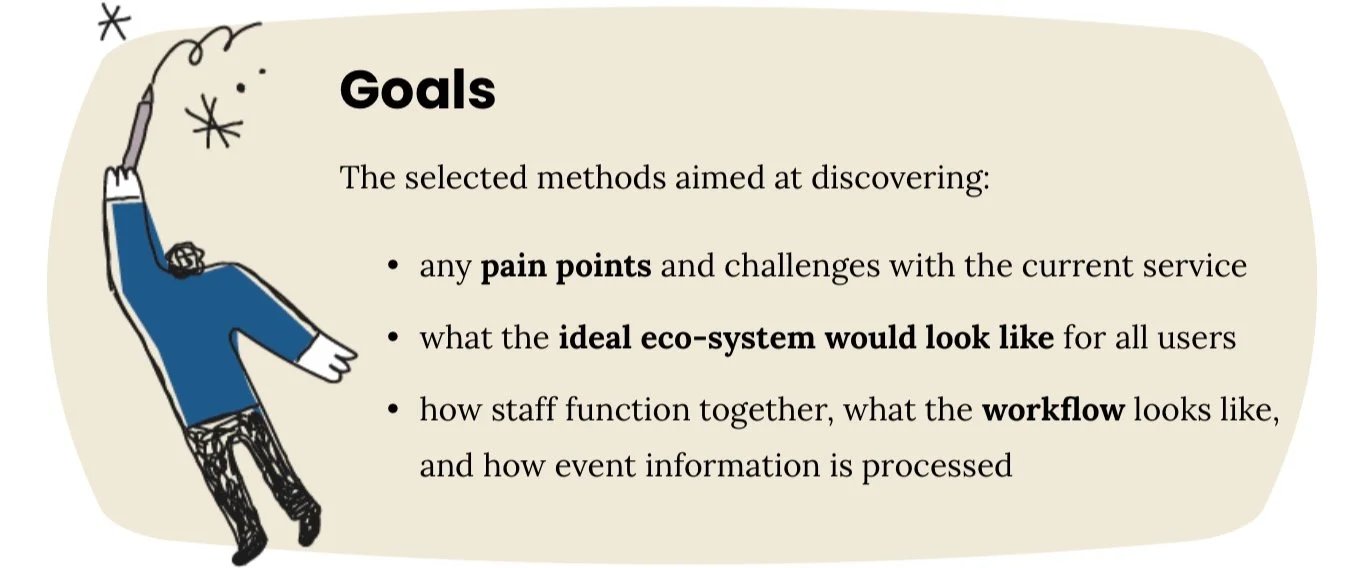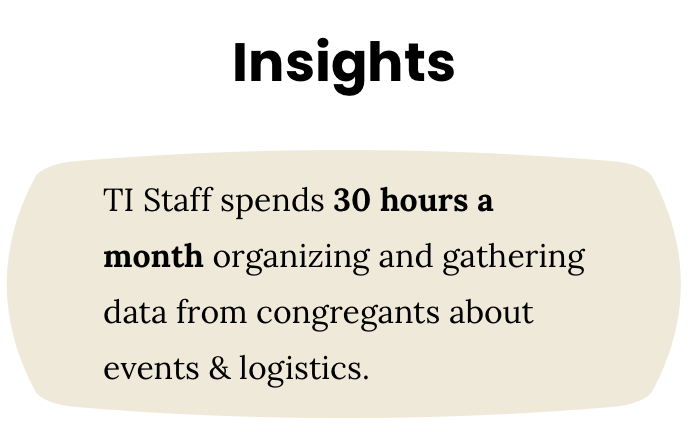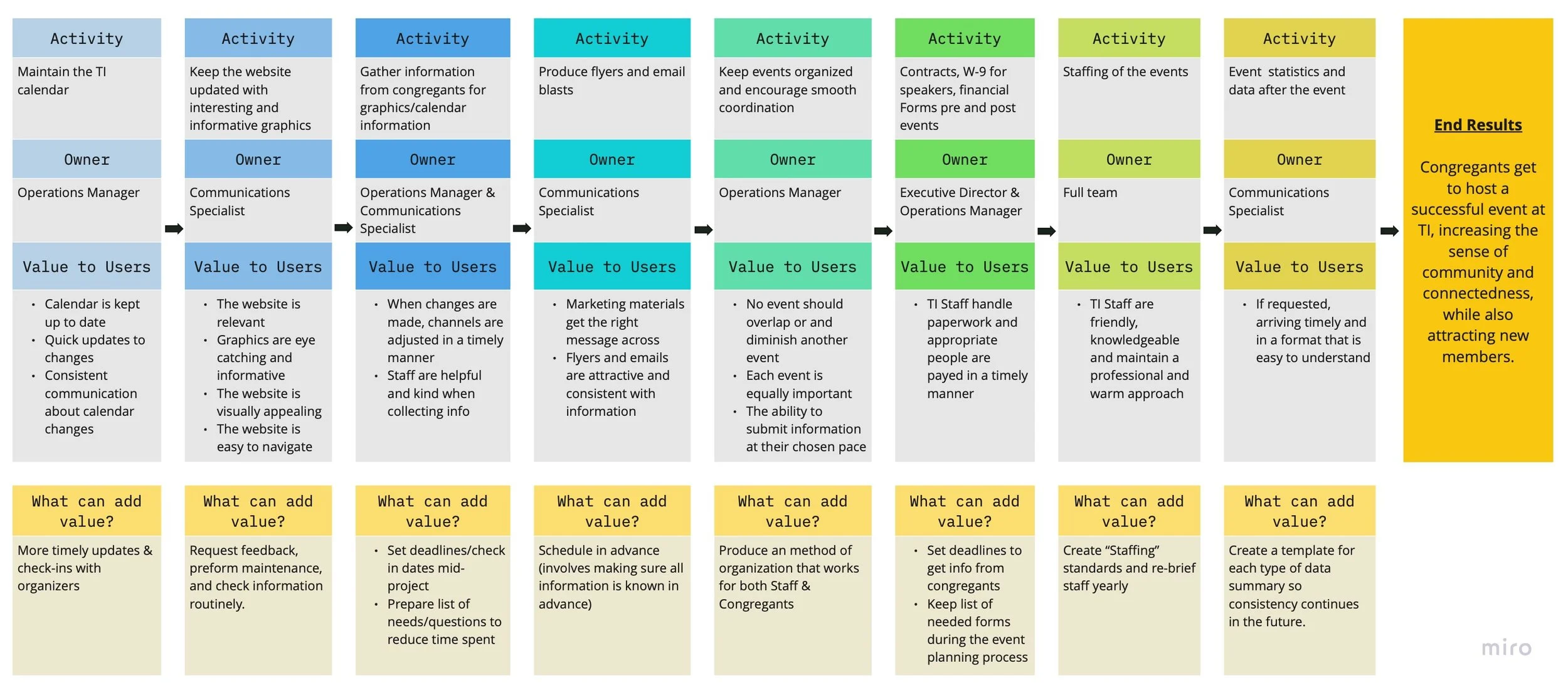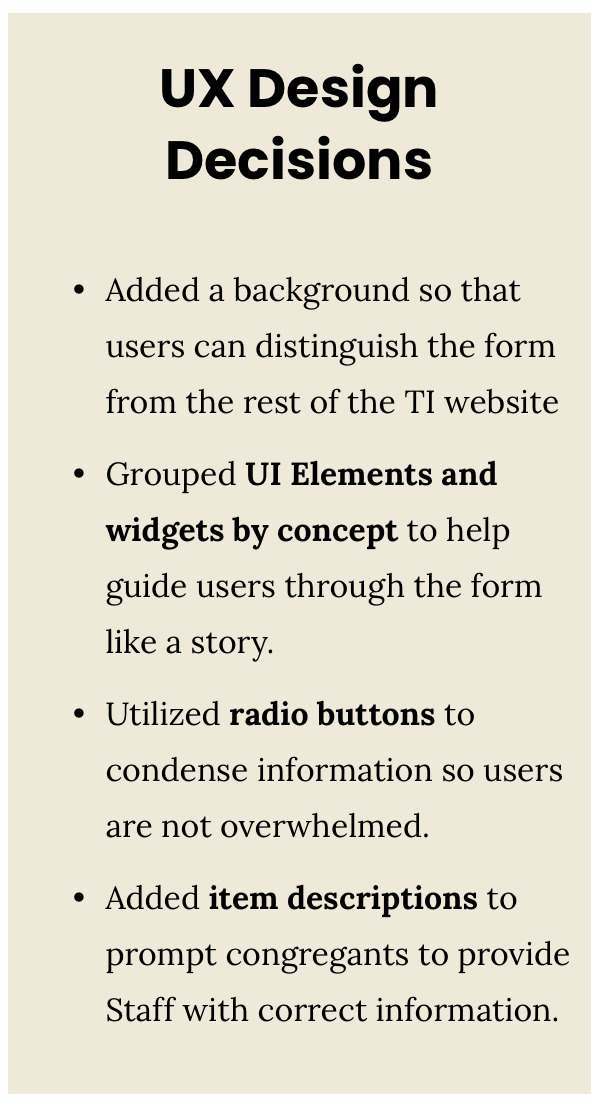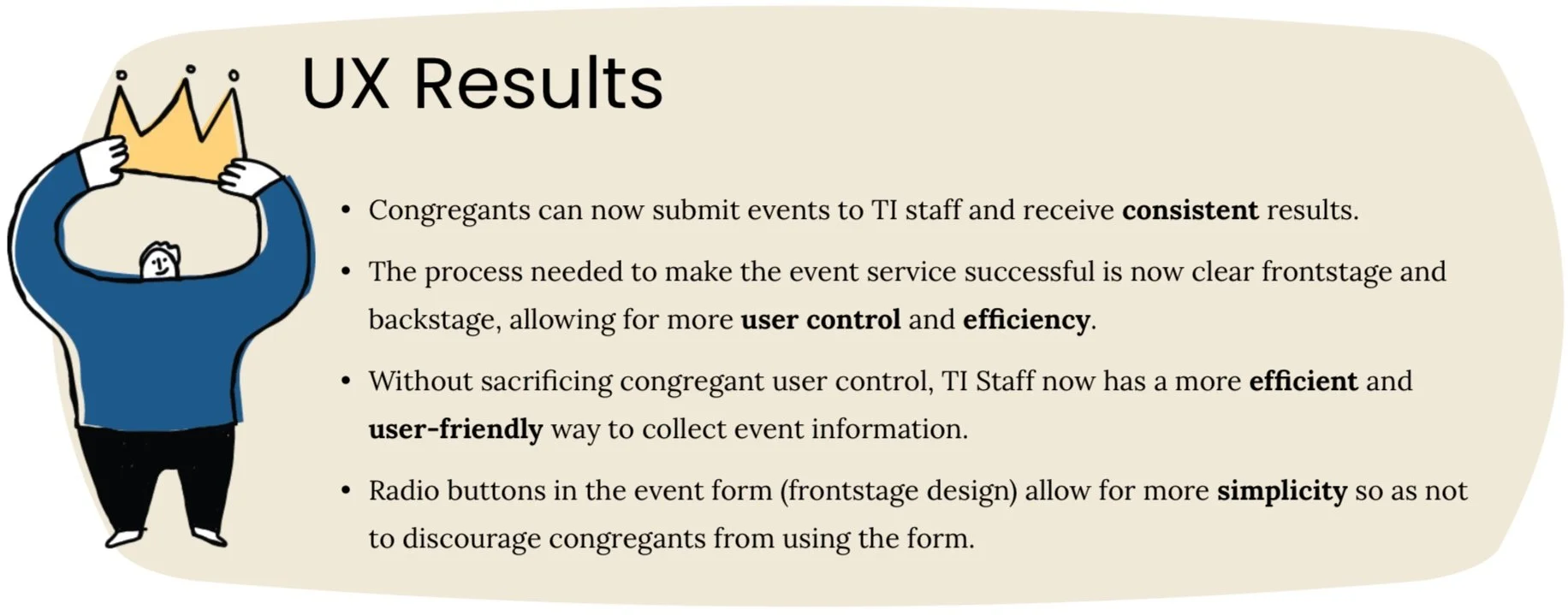REVOLUTIONIZING TIFERETH ISRAEL’S EVENT SERVICE
Providing User-Centric Frontstage & Backstage Solutions
Increased congregant-planned events by 15%
Team: Design Strategist, Service Designer & User Researcher (Myself), Project Manager (Executive Director), Usability Testers
Tools: Shulcloud, Miro, PowerPoint, Toggle, Zoom, IDEO Brainstorming Methods
Timeline: (May – August ‘20, January – April ‘21)
OVERVIEW
ROLE + IMPACT
My role as Communications & Development Specialist at Tifereth Israel Congregation (TI) allowed me to discover pain points in handling congregant-led events at TI. Because of this, I created valuable business and design solutions that would help reduce staff workloads and provide congregants with the event planning service they desired.
PROBLEM STATEMENT
The TI Staff needed help revolutionizing the event planning service to gain control over the organization of projects, workflow, and information that congregants submit to TI Staff – while prioritizing customer service and putting the congregant’s needs first.
TI has a history of unstructured workflows and prioritizing congregants' needs, but the solution should benefit both the TI Staff and the congregants. Discovering the challenges and pain points for the event planning service was the main driver when entering the research phase.
RESEARCH
SECONDARY RESEARCH
In 2019, the Executive Director hired me as a Communication Specialist, and after being in the role for a year and a half, I used my conversations with congregants, previous band-aid solutions, and the team’s Toggl account to gather secondary data.
Time spent on the Service needed to be equal to or less than the amount spent on Communications, which, according to the above deliverable, is significantly less. Learning more about this discrepancy became the next focus in the research phase.
USER PERSONAS
We identified two primary personas based on secondary research: Congregant and TI Staff Member. We were able to pull valuable emotional insights from both. The congregant persona is below.
Still figuring out how we could translate these challenges into steps toward a solution, I wanted to dig into where pain points arose in the event planning process, which led to creating a User Journey Map.
USER JOURNEY MAP
I conducted six interviews with congregants and four with staff members to see how they encountered the event planning service. Together, we found the following insights that I then turned into a User Journey Map from the Congregant’s perspective.
Analyzing the congregant’s journey this way confirmed my prior beliefs entering the research phase. At this point, I realized that two solutions would be necessary to improve the complete event planning service - one that was “user-facing” and one that made managing event information more efficient.
VALUE CHAIN ANALYSIS
After completing the User Journey Analysis, I wanted to understand the event planning service from the TI Staff’s perspective. To do this required a business-based approach to dig into the eco-system, which is why I decided to complete a Value Chain Analysis.
Completing this analysis helped establish the relationship between the specific tasks and the user’s emotional responses.
TURNING RESEARCH INTO DESIGN CRITERIA
Congregants are passionate about planning events, and the TI Staff want to help congregants succeed but need a more structured approach to streamline the event process.
Based on the research, an improved service should have the following design criteria. The solution should:
Establish delivery of consistent information, and be detailed but concise to be desirable to congregants
Be user-friendly so that all congregants can navigate, and centralized so that solution is easy to access for everyone
Be accessible to those with disabilities so that all can participate
Be sustainable so that it creates a vital building block for future protocol and low maintenance after the creation
Excite congregants to be timelier with their information
IDEATION & STRATEGY
BRAINSTORMING
I completed extensive brainstorming with a focus group of Congregants and two Staff Members using the following techniques:
NAPKIN PITCHES
The next step was to ideate solutions to create a portfolio of concepts to bring into the testing process. I developed four Napkin Pitches that focused on user and organization needs/benefits and how execution could work. You can see the selected Napkin Pitch below.
Creating the Napkin Pitches helped elaborate on organizational capabilities and goals and how each idea would create value for the organization and the users. It also helped focus on whether the ideas were attainable and able to be executed.
Minimizing risk for the client was essential by providing four or more Napkin Pitch solutions to test. The most sustainable and valuable idea was ultimately selected and brought into the prototyping phase.
PROTOTYPING
We selected the lead idea to improve upon TI’s Event Planning Service, the Event Planning Form, and brought it to life for the prototyping phase with two low-fidelity prototypes, a full process map, and Surface Key Assumptions.
Below you can see the full process map and a low-fidelity prototype with platform constraints.
Completing the prototyping phase helped minimize risk to TI by revealing the value, scalability, and sustainability of the lead idea. Getting stakeholder buy-in was the next and most crucial step of this project.
CLIENT INVESTMENT & TESTING
TI Staff and a few Congregants tested an adaptation of the low-fidelity prototype, expressed concerns, and provided critical insights that would help inform the presentation to stakeholders.
I took the idea to the stakeholders, and the presentation highlighted insights from research and testing with TI’s Staff and Congregants. The stakeholders saw the potential and value of the project and gave the go-ahead to begin the design phase.
DESIGN
FRONTSTAGE EVENT FORM
There was a six-month hiatus between this project's prototyping and final design stages. As predicted, the TI Staff became overloaded with High Holiday events and needed more time to prioritize this new change. Things finally slowed down in January 2021, when the design process began.
Keeping these constraints in mind, I designed a form that pushed past the limitations but met established users' needs. A section of the form is below.
BACKSTAGE PROCESS
After analyzing the data from the research and ideation phase and talking with team members, I designed a funneled process that answered the questions for intaking event information, which is below.
Ultimately, the event planning process stayed broad, allowing for flexibility in timelines depending on the event, situation, and user.
I checked in on TI about a year after the launch of the event form and can confirm that the organization is still using both the frontstage and backstage solutions but plan on making changes soon so it can grow with the community.
PROJECT OUTCOMES
REFLECTIONS
Implementation of the new service was complex with a small, busy team. In the future, I would take more time to focus on the structure of the process and how it fits within TI’s current workflow so that transitioning to the new service would be less daunting.
Staff requested many changes post-implementation, which was frustrating but also helped prove how flexible the new service was, especially when looking at the backstage process.


